Differences in the Physical Properties of Plant-Based Meat Alternatives Containing Root Vegetables
Abstract
1. Introduction
2. Materials and Methods
2.1. Samples
2.2. Moisture Content
2.3. Chromaticity
2.4. Texture Analysis
2.5. Cooking Loss
2.6. Shrinkage
2.7. Sensory Evaluation
2.8. Statistical Analysis
3. Results and Discussion
3.1. Moisture Content
3.2. Chromaticity
3.3. Texture Analysis
3.4. Cooking Loss and Shrinkage
3.5. Sensory Evaluation
4. Conclusions
Author Contributions
Funding
Institutional Review Board Statement
Informed Consent Statement
Data Availability Statement
Conflicts of Interest
References
- Park, S.N.; Sim, H.W.; Yu, S.B.; Han, H.J.; Jung, S.H. Alternative meat as future food, seeking a sustainable future. J. Korean Soc. Environ. Eng. 2023, 45, 491–505. [Google Scholar] [CrossRef]
- Jang, J.W.; Lee, D.W. Advancements in plant based meat analogs enhancing sensory and nutritional attributes. NPJ Sci. Food 2024, 8, 50. [Google Scholar] [CrossRef] [PubMed]
- Su, T.; Le, B.; Zhang, W.; Bak, K.H.; Soladoye, P.O.; Zhao, Z.; Zhao, Y.; Fu, Y.; Wu, W. Technological challenges and future perspectives of plant-based meat analogues: From the viewpoint of proteins. Food Res. Int. 2024, 186, 114351. [Google Scholar] [CrossRef] [PubMed]
- Hwang, J.; You, J.; Moon, J.; Jeong, J. Factors Affecting Consumers’ Alternative Meats Buying Intentions: Plant-Based Meat Alternative and Cultured Meat. Sustainability 2020, 12, 5662. [Google Scholar] [CrossRef]
- Schouteten, J.J.; De Steur, H.; De Pelsmaeker, S.; Lagast, S.; Juvinal, J.G.; De Bourdeaudhuij, I.; Verbeke, W.; Gellynck, X. Emotional and sensory profiling of insect-, plant-and meat-based burgers under blind, expected and informed conditions. Food Qual. Prefer. 2016, 52, 27–31. [Google Scholar] [CrossRef]
- Andreani, G.; Sogari, G.; Marti, A.; Froldi, F.; Dagevos, H.; Martini, D. Plant-Based Meat Alternatives: Technological, Nutritional, Environmental, Market, and Social Challenges and Opportunities. Nutrients 2023, 15, 452. [Google Scholar] [CrossRef]
- Vanhonacker, F.; Van Loo, E.J.; Gellynck, X.; Verbeke, W. Flemish consumer attitudes towards more sustainable food choices. Appetite 2013, 62, 7–16. [Google Scholar] [CrossRef]
- Riaz, M.N. 15—Texturized vegetable proteins. In Handbook of Food Proteins; Phillips, G.O., Williams, P.A., Eds.; Woodhead Publishing Series in Food Science, Technology and Nutrition; Woodhead Publishing: Sawston, UK, 2011; pp. 395–418. ISBN 978-1-84569-758-7. [Google Scholar] [CrossRef]
- Singh, M.; Trivedi, N.; Enamala, M.K.; Kuppam, C.; Parikh, P.; Nikolova, M.P.; Chavali, M. Plant-based meat analogue (PBMA) as a sustainable food: A concise review. Eur. Food Res. Technol. 2021, 247, 2499–2526. [Google Scholar] [CrossRef]
- He, J.; Evans, N.M.; Liu, H.; Shao, S. A review of research on plant-based meat alternatives: Driving forces, history, manufacturing, and consumer attitudes. Compr. Rev. Food Sci. Food Saf. 2020, 19, 2639–2656. [Google Scholar] [CrossRef]
- Lee, H.J.; Yong, H.I.; Kim, M.; Choi, Y.S.; Jo, C. Status of meat alternatives and their potential role in the future meat market—A review. Asian-Australas. J. Anim. Sci. 2020, 33, 1533–1543. [Google Scholar] [CrossRef]
- Kyriakopoulou, K.; Dekkers, B.; van der Goot, A.J. Chapter 6—Plant-Based Meat Analogues. In Sustainable Meat Production and Processing; Galanakis, C.M., Ed.; Academic Press: Cambridge, MA, USA, 2019; pp. 103–126. ISBN 978-0-12-814874-7. [Google Scholar] [CrossRef]
- Zhao, S.; Wang, L.; Hu, W.; Zheng, Y. Meet the meatless: Demand for new generation plant-based meat alternatives. Appl. Econ. Perspect. Policy 2022, 45, 4–21. [Google Scholar] [CrossRef] [PubMed]
- Neuhofer, Z.T.; Lusk, J.L. Most plant-based meat alternative buyers also buy meat: An analysis of household demographics, habit formation, and buying behavior among meat alternative buyers. Sci. Rep. 2022, 12, 13062. [Google Scholar] [CrossRef] [PubMed]
- Michel, F.; Hartmann, C.; Siegrist, M. Consumers’ associations, perceptions and acceptance of meat and plant-based meat alternatives. Food Qual. Prefer. 2021, 87, 104063. [Google Scholar] [CrossRef]
- Vallikkadan, M.S.; Dhanapal, L.; Dutta, S.; Sivakamasundari, S.K.; Moses, J.A.; Anandharamakrishnan, C. Meat Alternatives: Evolution, Structuring Techniques, Trends, and Challenges. Food Eng. Rev. 2023, 15, 329–359. [Google Scholar] [CrossRef]
- AOAC. Official Methods of Analysis, 16th ed.; Association of Official Analytical Chemists: Arlington, TX, USA, 2002. [Google Scholar]
- Mehmet, S.A.; Riza, T.; Mehmet, B.B.; Cengiz, C. An innovative technique for extending shelf life of strawberry: Ultrasound. LWT Food Sci. Technol. 2013, 52, 93–101. [Google Scholar] [CrossRef]
- Al-Dairi, M.; Pathare, P.B.; Al-Yahyai, R. Effect of Postharvest Transport and Storage on Color and Firmness Quality of Tomato. Horticulturae 2021, 7, 163. [Google Scholar] [CrossRef]
- Prasad, R.V.; Dhital, S.; Williamson, G.; Barber, E. Nutrient Composition, Physical Characteristics and Sensory Quality of Spinach-Enriched Wheat Bread. Foods 2024, 13, 2401. [Google Scholar] [CrossRef]
- Vu, G.; Zhou, H.; McClements, D.J. Impact of cooking method on properties of beef and plant-based burgers: Appearance, texture, thermal properties, and shrinkage. J. Agric. Food Res. 2022, 9, 100355. [Google Scholar] [CrossRef]
- Ryu, K.K.; Kang, Y.K.; Jeong, E.W.; Baek, Y.J.; Lee, K.Y.; Lee, H.G. Applications of various natural pigments to a plant-based meat analog. LWT 2023, 174, 114431. [Google Scholar] [CrossRef]
- Joo, S.Y.; Choi, H.Y. Antioxidant activity and quality characteristics of pork patties added with saltwort (Salicornia herbacea L.) powder. J. Korean Soc. Food Sci. Nutr. 2014, 43, 1189–1196. [Google Scholar] [CrossRef][Green Version]
- Lee, K.H.; Lee, C.Y.; Jang, H.B.; Choi, Y.S.; Jang, H.W. A study on the quality characteristics of plant-based patties with Tremella fuciformis. J. Korean Soc. Food Sci. Nutr 2023, 52, 301–306. [Google Scholar] [CrossRef]
- Mandliya, S.; Pratap-Singh, A.; Vishwakarma, S.; Dalbhagat, C.G.; Mishra, H.N. Incorporation of Mycelium (Pleurotus eryngii) in Pea Protein Based Low Moisture Meat Analogue: Effect on Its Physicochemical, Rehydration and Structural Properties. Foods 2022, 11, 2476. [Google Scholar] [CrossRef] [PubMed]
- Zhang, Z.A.; Xun, X.M.; Herman, R.A.; Zhang, Z.P.; Yan, C.H.; Gong, L.C.; Wang, J. Mulberry (Morus alba L.) leaf powder modified the processing of meat alternatives: Principal component analysis from apparent properties to chemical bonds. Food Chemistry 2024, 450, 139318. [Google Scholar] [CrossRef] [PubMed]
- Bakhsh, A.; Lee, E.Y.; Bakry, A.M.; Rathnayake, D.; Son, Y.M.; Kim, S.W.; Hwang, Y.H.; Joo, S.T. Synergistic effect of lactoferrin and red yeast rice on the quality characteristics of novel plant-based meat analog patties. LWT 2022, 171, 114095. [Google Scholar] [CrossRef]
- Liu, M.; Wang, Y.; Zhu, L.; Zhao, X. Effects of Haematococcus pluvialis Addition on the Sensory Properties of Plant-Based Meat Analogues. Foods 2023, 12, 3435. [Google Scholar] [CrossRef]
- Cho, H.S.; Lee, H.J.; Lee, S.J.; Shin, J.H.; Lee, H.U.; Sung, N.J. Antioxidative Effects of Pleurotus eryngii and Its By-products. J. Life Sci. 2008, 18, 1360–1368. [Google Scholar] [CrossRef]
| Control (%) | RV-1 (%) | RV-3 (%) | RV-5 (%) | |
|---|---|---|---|---|
| Purified water | 32 | 32 | 32 | 32 |
| PVT | 31 | 31 | 30 | 30 |
| Pleurotus eryngii | 15 | 14 | 14 | 12 |
| Rape seed oil | 16 | 16 | 16 | 16 |
| Root vegetable | 0 | 1 | 3 | 5 |
| Compound seasoning | 6 | 6 | 5 | 5 |
| Sample | Moisture Contents (% w.b.) | |
|---|---|---|
| Control | 55.53 ± 0.31 a | |
| Platycodon grandiflorum | RV-1 | 60.93 ± 0.62 b |
| RV-3 | 61.30 ± 0.94 b | |
| RV-5 | 61.07 ± 0.09 b | |
| Codonopsis lanceolata root | RV-1 | 60.30 ± 0.24 b |
| RV-3 | 60.23 ± 0.34 b | |
| RV-5 | 61.15 ± 0.97 b | |
| Gastrodia elata blume | RV-1 | 60.87 ± 0.81 b |
| RV-3 | 61.13 ± 0.45 b | |
| RV-5 | 61.80 ± 1.02 b | |
| Panax ginseng | RV-1 | 59.67 ± 0.46 b |
| RV-3 | 60.90 ± 0.49 b | |
| RV-5 | 61.20 ± 0.93 b | |
| Sample | Before Heating | After Heating | |||||
|---|---|---|---|---|---|---|---|
| L* | a* | b* | L* | a* | b* | ||
| control | 71.95 ± 1.17 a | 3.60 ± 0.45 efg | 14.75 ± 0.79 c | 62.50 ± 2.22 a | 5.10 ± 0.82 a | 17.98 ± 1.36 a | |
| Platycodon grandiflorum | RV-1 | 66.32 ± 3.25 e | 5.47 ± 0.77 bc | 17.17 ± 1.04 b | 54.18 ± 2.86 bc | 4.48 ± 0.96 a | 12.61 ± 1.84 c |
| RV-3 | 69.03 ± 2.40 b | 5.91 ± 0.43 b | 18.33 ± 0.58 b | 52.08 ± 2.70 c | 5.03 ± 0.76 a | 14.48 ± 1.71 b | |
| RV-5 | 67.30 ± 2.95 bc | 6.78 ± 1.22 a | 20.65 ± 1.66 a | 52.05 ± 2.79 c | 5.30 ± 0.80 a | 14.36 ± 1.27 b | |
| Codonopsis lanceolata root | RV-1 | 56.59 ± 3.68 bc | 4.87 ± 0.22 cd | 13.33 ± 0.95 d | 55.07 ± 2.99 bc | 4.88 ± 0.74 a | 14.00 ± 0.88 b |
| RV-3 | 63.09 ± 1.37 d | 4.30 ± 0.46 de | 13.32 ± 1.15 d | 53.02 ± 2.65 bc | 5.17 ± 0.86 a | 14.23 ± 1.35 b | |
| RV-5 | 63.03 ± 2.89 d | 4.24 ± 0.72 de | 13.20 ± 0.81 d | 53.14 ± 3.54 bc | 4.30 ± 0.91 a | 14.32 ± 1.38 b | |
| Gastrodia elata blume | RV-1 | 68.22 ± 3.06 b | 3.36 ± 0.96 fg | 12.17 ± 2.24 de | 53.97 ± 3.20 bc | 4.74 ± 1.11 a | 14.25 ± 1.35 b |
| RV-3 | 67.43 ± 1.71 bc | 3.71 ± 0.50 efg | 11.71 ± 0.83 e | 55.63 ± 1.83 bc | 4.56 ± 0.70 a | 14.40 ± 1.25 b | |
| RV-5 | 67.12 ± 2.09 bc | 3.21 ± 0.29 fg | 11.21 ± 0.74 e | 52.55 ± 2.99 bc | 5.23 ± 1.15 a | 14.24 ± 1.42 b | |
| Panax ginseng | RV-1 | 66.89 ± 0.88 bc | 3.87 ± 0.58 ef | 12.59 ± 1.19 de | 56.01 ± 3.51 b | 4.50 ± 0.97 a | 14.28 ± 1.32 b |
| RV-3 | 64.98 ± 2.21 cd | 3.87 ± 0.54 ef | 12.56 ± 0.88 de | 53.62 ± 2.72 bc | 5.34 ± 0.69 a | 14.50 ± 0.74 b | |
| RV-5 | 67.84 ± 1.47 bc | 3.06 ± 0.51 g | 12.17 ± 1.51 de | 53.35 ± 3.00 bc | 5.17 ± 0.85 a | 14.71 ± 1.05 b | |
| Control | Before Heating | After Heating | ||||
|---|---|---|---|---|---|---|
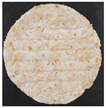 | 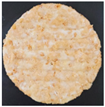 | |||||
| RV-1 | RV-3 | RV-5 | RV-1 | RV-3 | RV-5 | |
| Platycodon grandiflorum | 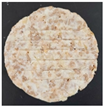 | 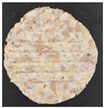 | 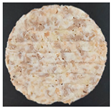 |  | 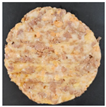 | 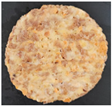 |
| Codonopsis lanceolata root | 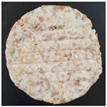 |  | 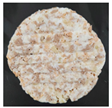 |  | 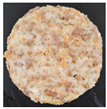 | 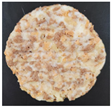 |
| Gastrodia elata blume | 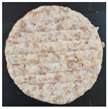 |  |  |  | 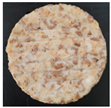 |  |
| Panax ginseng | 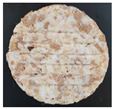 |  |  |  | 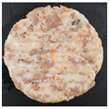 |  |
| Hardness (N) | Cohesiveness (%) | Gumminess (%) | Springiness (%) | Chewiness (g) | ||
|---|---|---|---|---|---|---|
| Control | 1.65 ± 0.37 ab | 59.66 ± 4.04 ab | 98.08 ± 20.06 ab | 69.56 ± 5.45 a | 0.68 ± 0.14 abc | |
| Platycodon grandiflorum | RV-1 | 1.05 ± 0.34 d | 50.04 ± 6.86 c | 52.30 ± 18.61 e | 56.83 ± 7.67 b | 0.31 ± 0.14 d |
| RV-3 | 1.07 ± 0.34 d | 49.75 ± 5.93 c | 52.54 ± 15.36 e | 54.97 ± 5.34 b | 0.29 ± 0.10 d | |
| RV-5 | 1.02 ± 0.41 d | 50.33 ± 9.10 c | 49.26 ± 14.34 e | 57.05 ± 9.40 b | 0.28 ± 0.11 d | |
| Codonopsis lanceolata root | RV-1 | 1.67 ± 0.37 ab | 62.48 ± 3.68 ab | 103.85 ± 20.99 ab | 72.22 ± 4.06 a | 0.75 ± 0.16 ab |
| RV-3 | 1.47 ± 0.27 bc | 58.63 ± 6.94 b | 86.41 ± 19.30 bcd | 70.43 ± 5.85 a | 0.61 ± 0.17 bc | |
| RV-5 | 1.93 ± 0.64 a | 58.83 ± 3.50 b | 112.49 ± 34.20 a | 72.61 ± 4.05 a | 0.83 ± 0.28 a | |
| Gastrodia elata blume | RV-1 | 1.56 ± 0.34 abc | 64.42 ± 4.17 ab | 99.93 ± 19.76 ab | 74.58 ± 3.82 a | 0.74 ± 0.14 ab |
| RV-3 | 1.59 ± 0.29 abc | 59.09 ± 4.59 b | 93.40 ± 14.63 abc | 70.71 ± 3.97 a | 0.66 ± 0.12 abc | |
| RV-5 | 1.72 ± 0.49 ab | 60.64 ± 4.53 ab | 104.16 ± 29.83 ab | 73.48 ± 5.55 a | 0.77 ± 0.25 ab | |
| Panax ginseng | RV-1 | 1.24 ± 0.39 cd | 62.22 ± 5.24 ab | 75.77 ± 21.08 cd | 70.40 ± 5.64 a | 0.53 ± 0.15 c |
| RV-3 | 1.04 ± 0.40 d | 65.08 ± 6.36 a | 67.95 ± 27.78 de | 73.17 ± 6.00 a | 0.51 ± 0.24 c | |
| RV-5 | 1.10 ± 0.36 d | 62.42 ± 6.43 ab | 68.36 ± 21.55 de | 73.95 ± 6.01 a | 0.51 ± 0.17 c | |
| Sample | Hardness (N) | Cohesiveness (%) | Gumminess (%) | Springiness (%) | Chewiness (g) | |
|---|---|---|---|---|---|---|
| Control | 5.13 ± 1.62 c | 56.28 ± 4.04 abcd | 285.42 ± 85.70 bc | 72.98 ± 5.33 a | 2.08 ± 0.64 abc | |
| Platycodon grandiflorum | RV-1 | 7.06 ± 1.32 ab | 51.93 ± 6.86 de | 366.47 ± 71.59 ab | 71.74 ± 4.17 a | 2.64 ± 0.60 a |
| RV-3 | 7.52 ± 3.23 a | 53.03 ± 5.93 bcde | 383.88 ± 138.72 a | 71.28 ± 4.46 a | 2.71 ± 0.93 a | |
| RV-5 | 6.77 ± 2.03 ab | 54.16 ± 9.10 abcde | 361.27 ± 93.12 ab | 71.88 ± 4.83 a | 2.59 ± 0.67 ab | |
| Codonopsis lanceolata root | RV-1 | 4.99 ± 1.24 c | 57.93 ± 3.68 abc | 287.13 ± 66.31 bc | 72.18 ± 5.22 a | 2.09 ± 0.56 abc |
| RV-3 | 4.95 ± 1.58 c | 59.14 ± 6.94 a | 287.64 ± 82.20 bc | 74.67 ± 3.10 a | 2.15 ± 0.63 abc | |
| RV-5 | 5.14 ± 1.77 c | 58.26 ± 3.50 ab | 298.13 ± 112.01 bc | 72.18 ± 4.87 a | 2.17 ± 0.90 abc | |
| Gastrodia elata blume | RV-1 | 4.93 ± 1.20 c | 56.34 ± 4.17 abcd | 273.47 ± 51.55 c | 71.95 ± 3.94 a | 1.97 ± 0.38 bc |
| RV-3 | 4.99 ± 1.07 c | 52.49 ± 4.59 de | 262.12 ± 59.07 c | 71.51 ± 3.50 a | 1.88 ± 0.47 c | |
| RV-5 | 4.55 ± 1.25 c | 52.02 ± 4.53 de | 235.71 ± 66.27 c | 72.67 ± 5.11 a | 1.72 ± 0.51 c | |
| Panax ginseng | RV-1 | 4.37 ± 0.94 c | 56.62 ± 5.24 abcd | 244.64 ± 46.52 c | 70.91 ± 2.87 a | 1.73 ± 0.34 c |
| RV-3 | 4.97 ± 1.82 c | 49.02 ± 6.36 e | 242.19 ± 89.34 c | 70.01 ± 4.58 a | 1.69 ± 0.61 c | |
| RV-5 | 5.88 ± 1.31 bc | 52.78 ± 6.43 cde | 307.99 ± 59.26 abc | 74.17 ± 3.78 a | 2.29 ± 0.45 abc | |
| Sample | Cooking Loss (%) | Shrinkage (%) | |
|---|---|---|---|
| Control | 13.43 ± 0.80 e | 17.27 ± 1.62 ab | |
| Platycodon grandiflorum | RV-1 | 20.06 ± 0.62 b | 19.60 ± 2.59 ab |
| RV-3 | 23.33 ± 0.89 a | 27.14 ± 6.60 a | |
| RV-5 | 23.22 ± 0.90 a | 26.18 ± 2.84 a | |
| Codonopsis lanceolata root | RV-1 | 15.54 ± 0.55 d | 17.34 ± 2.88 ab |
| RV-3 | 17.11 ± 0.44 cd | 17.54 ± 1.56 ab | |
| RV-5 | 16.22 ± 0.59 d | 16.50 ± 0.87 ab | |
| Gastrodia elata blume | RV-1 | 16.23 ± 0.57 d | 19.78 ± 3.97 ab |
| RV-3 | 17.24 ± 0.48 cd | 19.07 ± 4.49 ab | |
| RV-5 | 16.09 ± 0.81 d | 15.03 ± 0.57 b | |
| Panax ginseng | RV-1 | 15.84 ± 0.97 d | 18.38 ± 1.39 ab |
| RV-3 | 16.34 ± 0.30 d | 20.04 ± 0.29 ab | |
| RV-5 | 18.54 ± 0.56 bc | 22.04 ± 2.20 ab | |
| Sample | Cooking | Sensory Evaluation (Point) | ||||
|---|---|---|---|---|---|---|
| Appearance | Aroma | Flavor | Texture | Overall Acceptability | ||
| Control | Before | 6.3 ± 0.6 a | 5.7 ± 0.4 a | - | 4.7 ± 0.3 a | 5.7 ± 0.4 a |
| After | 6.8 ± 0.5 bcde | 6.2 ± 0.5 bc | 6.6 ± 0.4 a | 6.0 ± 0.5 b | 6.4 ± 0.4 c | |
| Platycodon grandiflorum | Before | 6.7 ± 0.3 abcd | 5.9 ± 0.4 ab | - | 6.4 ± 0.3 c | 6.6 ± 0.2 cd |
| After | 7.2 ± 0.3 e | 6.9 ± 0.2 d | 7.6 ± 0.4 b | 7.3 ± 0.3 d | 7.5 ± 0.2 f | |
| Codonopsis lanceolata root | Before | 6.5 ± 0.3 abc | 6.0 ± 0.4 ab | - | 6.8 ± 0.3 c | 6.0 ± 0.2 ab |
| After | 7.1 ± 0.2 e | 6.5 ± 0.2 cd | 7.2 ± 0.4 b | 7.4 ± 0.2 d | 7.1 ± 0.3 ef | |
| Gastrodia elata blume | Before | 6.4 ± 0.3 ab | 5.8 ± 0.3 ab | - | 6.6 ± 0.3 c | 5.9 ± 0.3 ab |
| After | 6.9 ± 0.2 cde | 6.5 ± 0.3 cd | 6.7 ± 0.2 a | 7.2 ± 0.2 d | 6.9 ± 0.3 de | |
| Panax ginseng | Before | 6.5 ± 0.3 abc | 5.9 ± 0.4 ab | - | 6.7 ± 0.3 c | 6.3 ± 0.4 bc |
| After | 7.0 ± 0.2 de | 6.8 ± 0.3 d | 6.8 ± 0.3 a | 7.3 ± 0.2 d | 7.3 ± 0.3 f | |
Disclaimer/Publisher’s Note: The statements, opinions and data contained in all publications are solely those of the individual author(s) and contributor(s) and not of MDPI and/or the editor(s). MDPI and/or the editor(s) disclaim responsibility for any injury to people or property resulting from any ideas, methods, instructions or products referred to in the content. |
© 2024 by the authors. Licensee MDPI, Basel, Switzerland. This article is an open access article distributed under the terms and conditions of the Creative Commons Attribution (CC BY) license (https://creativecommons.org/licenses/by/4.0/).
Share and Cite
Kim, S.-Y.; Lee, D.-H.; Lee, J.-J.; Park, S.-Y.; Choi, S.-G.; Choi, Y.-J.; Lee, J.-H. Differences in the Physical Properties of Plant-Based Meat Alternatives Containing Root Vegetables. Foods 2024, 13, 3746. https://doi.org/10.3390/foods13233746
Kim S-Y, Lee D-H, Lee J-J, Park S-Y, Choi S-G, Choi Y-J, Lee J-H. Differences in the Physical Properties of Plant-Based Meat Alternatives Containing Root Vegetables. Foods. 2024; 13(23):3746. https://doi.org/10.3390/foods13233746
Chicago/Turabian StyleKim, Si-Yun, Dong-Han Lee, Jeong-Jae Lee, Seo-Young Park, Seong-Gyu Choi, You-Jin Choi, and Jung-Hyun Lee. 2024. "Differences in the Physical Properties of Plant-Based Meat Alternatives Containing Root Vegetables" Foods 13, no. 23: 3746. https://doi.org/10.3390/foods13233746
APA StyleKim, S.-Y., Lee, D.-H., Lee, J.-J., Park, S.-Y., Choi, S.-G., Choi, Y.-J., & Lee, J.-H. (2024). Differences in the Physical Properties of Plant-Based Meat Alternatives Containing Root Vegetables. Foods, 13(23), 3746. https://doi.org/10.3390/foods13233746





